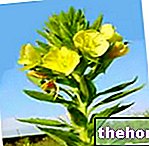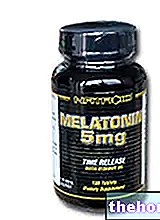First name: Thymus Vulgaris
Family: Labiatae
Thyme is a plant widely used in cooking to flavor different types of dishes, but it is above all endowed with marked therapeutic activities. It looks like a 20 to 30 cm tall shrub; in Italy it grows almost everywhere in sunny and arid areas.
The thyme: properties
Thyme has been known and used since the Middle Ages as a strengthening and restorative, indicated to regularize the menstrual cycle and eliminate various types of parasites, useful against headaches, rheumatic pains, inflammation of the mouth and throat.

Once the essential oil of thyme has been ingested, its components are filtered into the blood through the intestine, then eliminated from the body through the pulmonary alveoli: in this way the active ingredients act directly naturally on the mucous membranes of the system. respiratory.
The most used formulation is the thyme tea, useful against the constriction of the airways; however, the benefits of thymus are not only localized in the respiratory tract, but are also found in the digestive tract, reducing the sense of bloating and stimulating digestion.
Thyme also has pain-relieving properties and is used in the formulation of ointments for the treatment of wounds and bruises, thanks also to its intrinsic antiseptic action.
Thyme represents a real natural antibiotic; clinical studies have in fact shown that several pathogenic species are sensitive to this plant; among the sensitive pathogenic bacteria we find the genus Proteus, Staphylococci, Streptococci, Pneumococci, Enterococci, Candida albicans and Corinebacteria.
Thyme essential oils
As previously mentioned, various essential oils are present in thyme, up to 50% of thymol, and to a much lesser extent carvacrol, terpineol, borneol, linalool, geraniol, tujanol; it also contains tannins with antiviral action (3.5-7.5%), flavonoids, saponins and triterpenes with antibiotic activity.
The antibacterial action of thyme is mainly ascribed to thymol and carvacrol: these essential oils belong to the group of phenols, substances with bactericidal power.
Linalool and tujanol also have important characteristics from a phytotherapeutic point of view: they are scented, stimulate the nervous system and have antibacterial properties; they perform a gentle and non-irritating action, unlike thymol which should therefore be avoided by people with sensitive skin.
Each essential oil is characterized by a chemotype that differentiates its chemical characteristics, consequently the therapeutic ones; therefore, when choosing an essential oil of thyme, it is necessary to pay close attention to the prevailing chemotype. If the essential oil of thyme is made up of up to 60% phenols, it is called thymol chemotype; among all, it is the one that develops the most powerful antibacterial action: in case you want to treat infectious diseases it is certainly the most useful, but you must be careful not to apply it pure on the skin or mucous membranes (mouth and eyes in particular) because it is very irritating. Beware of those with thyroid problems: this type of oil has a "stimulating action on the thyroid gland, even if at normal doses there are no risks , especially if you consume thyme tea.
Oils composed of up to 50% of tujanol have a strengthening and toning effect on the whole organism, stimulate the immune system and, very importantly, are not irritating to the skin; tujanol has antiviral power, and for this reason it is indicated in cases of bronchitis and flu, and antibiotic, in fact, it is effective against Chlamydia, a microorganism responsible for infections of the eyes and genital organs.
The linalool chemotype contains up to 60% of linalool and exerts formidable antiseptic effects, while remaining delicate and well tolerated by the skin; it is particularly effective against Candida albicans and staphylococci, a group of pathogenic bacteria capable of causing diseases of the skin, intestines, bladder and urogenital tract.
The last important chemotype is the one where the main component is geraniol, well tolerated by the organism with a strong action against bacteria, viruses and fungi; in addition to the antiseptic action, this type of oil has calming effects on the nervous system and promotes sleep.
As often happens, studies conducted on patients have shown that the synergy between the various types of essential oils proves to be much more effective than the administration of a single chemotype.
In addition to the essential oils extracted from the thyme, the flowering tops of this plant are also used for pharmacological purposes: the harvest takes place between May and July, when the stems are cut, taking care to avoid the woody parts; after drying these are crushed and stored in glass or ceramic containers.
There are no known interactions with synthetic drugs of thyme, despite the increasingly widespread use; the only side effects are due to an excessive use of essential oils: in addition to the stimulatory effects on the thyroid, the ingestion of excessive quantities of essential oil it can cause, due to the presence of thymol and carvacrol, gastrointestinal disturbances such as nausea, vomiting and headache. In the most extreme and severe cases of intoxication it can lead to central nervous system depression.
Recipes and therapeutic indications
Infusion of thyme for the respiratory tract
Pour ¼ liter of boiling water over a tablespoon of dried and chopped thyme.
Leave to infuse for 15 minutes and filter: cover the container with a lid to avoid dispersing the essential oils.
In case of cough and bronchitis you can drink up to 5 cups a day.
Lozenges for sore throats and tonsillitis
Charcoal tablets, linalool chemotype thyme essential oil and tujanol chemotype thyme essential oil are used.
Pour 2 drops of both essential oils over the charcoal tablet and let it dissolve slowly in the mouth: repeat 2-3 times a day.
Select plant Fir Acacia Acerola Sorrel Yarrow Yarrow Yarrow Aconito Adatoda Garlic Agnocasto Agrimonia Alchemilla Alkekengi Aloe Altea Witch Hazel Ammi or Visnaga Pineapple Andrographis Anemone Pulsatilla Angelica Anise Star Anise Japanese Star Anise Bitter Orange Bitter Areca Arnica Harpagophytum Arpagophyte Artemisia Asteragus Basil Asparagus Asparagus Peruvian Asparagus Asparagus Asparagus Hawthorn Boldo Borage Shepherd's Purse Boswellia Bucco Butea superba Cocoa Coffee Cajeput Calamus Calamus Marigold Camedrio Chamomile Roman Chamomile Camphor Cinnamon Ceylon Maidenhair Capuchin Artichoke Cardamom Cardiac Thistle Asian Thistle Carvi Cascara Cassia Catecu Catha Cabbage Celandine Chicory Centaurea Cinnamon Cypress Celandine Chives Cypress Coca Cola Colchico Combreto Condurango Comfrey Coriander Cranberry Barberry American Chrysanthemum Cumin Turmeric Damiana Digital Dioscorea Drosera Dulcamara Dunalilella Echinacea Eder a Ephedra Elenio Eleutherococcus Helichrysum Evening primrose Horsetail Alfalfa Erica Euphrasia Erisimo Escolzia Eucalyptus Farfara Farfaraccio Calabar bean Fenugreek Fennel Phytolacca Frangola Ash Fumaria Japanese Mushrooms Galega Ganoderma lucidum Garcinia Cambogia Mulberry Gentian Broom Ginkgo Ginkgo Guipana Guipana Gynestra Ginkgo Hibelia Gymnasium Hibiscus Guarulp St. John's Wort Horse Chestnut Ispaghul Hyssop Jaborandi Kava kava Konjac Laminaria Cherry Laurel Lavender Lemongrass Lespedeza Lovage Icelandic Lichen Lemon Flax Lippia Licorice Lobelia Hops Maca Marjoram Maize Mallow Manna Marrubio Marrubio d "water Matè Melaleuca Meliloto American Lemon balm Myrtle Myrama Walnut Nutmeg Walnut vomica Olive tree Meadowsweet Ononide Opuntia Oregano Orthosiphon Nettle Poppy Papaya Parietaria Feverfew Passiflora Chilli Perilla Periwinkle Phyllanthus Plantain Picrorhiza Pilosella Pino Pisci dia Podofillo Polygala Grapefruit Parsley Psyllium Pueraria mirifica Butcher's broom Pygeum Quassia Oak Rhubarb Ratania Rauwolfia currant Castor bean Rhodiola Rosehip Rosemary Rue Willow Sarsaparilla Sage Elderberry Sassafras Sedum Ergot Senna Serenoa Repens Soybean Solidago Tansy Taraxus Tamarind Tamarind Tamarind Tamarind Tamarindo Ursina Valerian Vanilla Mullein Verbena Veronica Viburnum Vinca Pansy Mistletoe Vine Withania Yohimbe Saffron Ginger Pumpkin Select disease Juvenile Acne Rosacea Tinnitus Tinnitus Aerophagia Tendon Affections Afonia Aphthae Algias Functional Halitosis Breastfeeding Allergy Anemia Anguish Anxiety Arteriosclerosis Asthrosis Asthrosis Arthritis Arthritis Men Sex Woman Blepharitis and Conjunctivitis Eye bags Bronchitis Gallstones Kidney stones Salivary stones Baldness Androgenetic Candida Fragile hair Caries Headache Cellulitis Motion sickness Cystitis C limaterio Cholecystopathy High cholesterol Ulcerative colitis Colonoscopy Contusions Hematoma Convalescence Couperose Depression Dermatitis Diaper dermatitis Diabetes Diarrhea Erectile dysfunction Dyslipidemia Dysmenorrhea Dyspepsia Disturbances of vision Hemorrhoids Epistaxis Herethism Heart disease Fever Fibromyalgia Gastro-intestinal disease Flatulence Hypertension Fibromyalgia Gastrointomnia Jaundice Laryngitis Renal lithiasis Toothache Sore throat Thinness Menopause Meteorism Mononucleosis Alzheimer's disease Crohn's disease Nausea Vomiting Obesity Dark circles Onychomycosis Osteoporosis Dry skin Periarthritis Piorea Low pressure Prostatitis Psoriasis Colds Breast fissures Anal fissures Gastro-nasal rhinitis Senescence Premenstrual Syndrome Sinusitis Quit smoking Overweight Fatty liver Constipation Stomatitis Stress Cough Triglycerides high Ulcer Burns Nails Brittle flashes Heat Warts Dizziness Properties herbal Tanning Abortive adaptogenic Aphrodisiac bittering analgesic anesthetic anorectics analgesic antacid anti-allergic anti-asthmatic Antibiotic catarrh Anticellulitiche anticonvulsant Antidiaforetiche antidiarrheal edematous anthelmintic antiemetic Antiemorroidarie antiphlogistic Antiidrotiche Antinevrotiche Antioxidants antipyretic antirheumatic antiscorbutic Antiseptic antispasmodic anti-uric Aperitive Flavoring Astringent Balsamic Bechiche Capillarotrope Cardiotonic Carminative Cathartic Caustics Healing Cholagogues Choleretic Dyes Decongestants Deodorants Purifying Diaphoretic Cleansers Disinfectants Detoxifiers Thirst quenching Diuretics Exciting Emetics Emmenagogues Emollients Hemostatic Energies Hepatoprotectors Expectorants Eupepticus Moisturisers Galactosensitizers lanti Hypertensive Hypnotic Hypoglycemic Hypotensive Irritants Laxatives Soothing Narcotic Nerves Nutrients Odontalgic Pectoral Purgative Revulsive Remineralizing Refreshing Rubefacient Scialagoghe Sedative Soporifugas Sneezing Stomachic Stomatics Narcotic Vascular Tightenitis




























